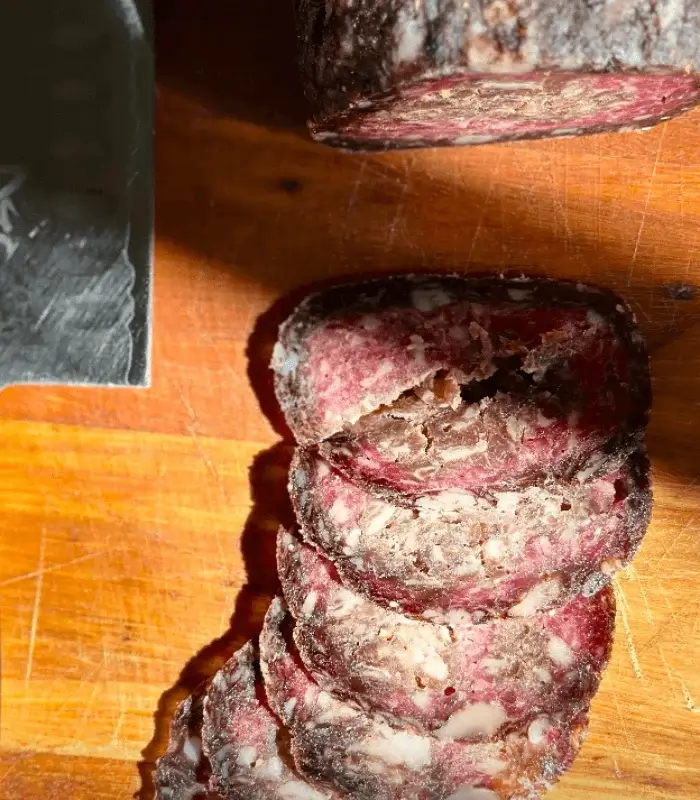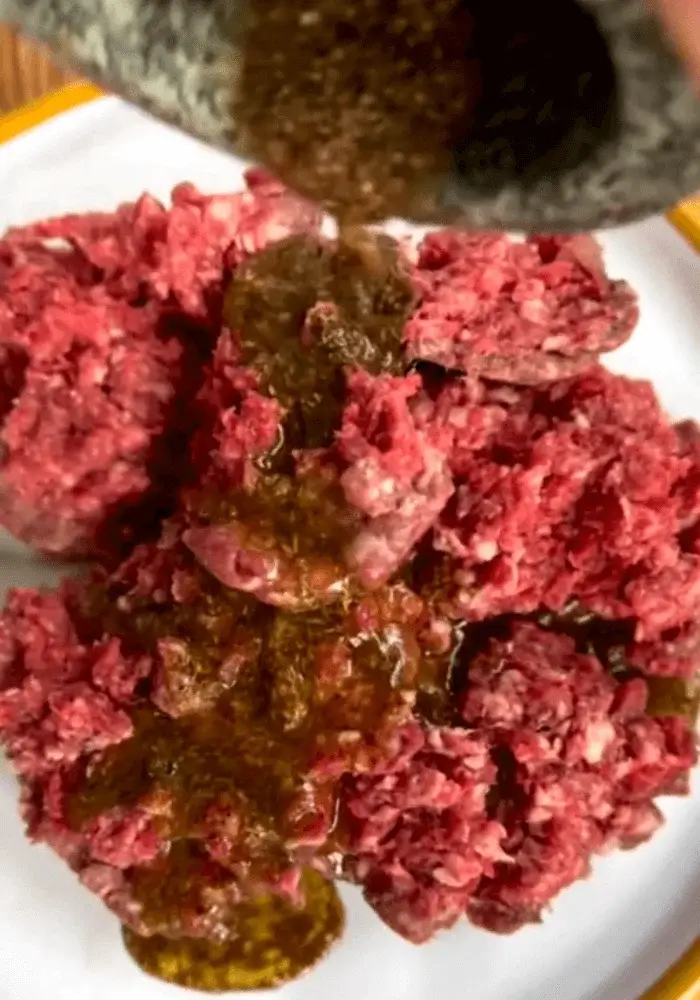Whisky-Cured Beef Salami Recipe
We may earn a commission from recommended products, at no extra cost to you. See Disclosure.
- Mortar and pestle
- Large mixing bowl
- Kitchen twine
- Tray
- Chef's knife
INGREDIENTS
- 1.1 pounds/500 grams beef ribs
- 1.1 pounds/500 grams chuck eye roll, entrecôte cap
- 1 teaspoon red pepper
- 1 teaspoon green pepper
- 1 teaspoon black pepper
- ½ teaspoon allspice
- 1 teaspoon coriander seeds
- 2 whisky shots, smoky, if preferred
- 1 tablespoon olive oil
- 4.4 pounds/2 kilograms coarse salt, for curing
- Pickling liquid, from cucumbers, cabbage, turnips, etc., as needed
INSTRUCTIONS
- Ask a skilled butcher to coarsely grind the beef ribs and chuck eye roll together. Using a mortar and pestle, crush the coriander seeds just enough to break them apart—avoid grinding them into a fine powder. In a large mixing bowl, combine the ground meat with the red, green, and black pepper, allspice, crushed coriander, whisky, and olive oil. Mix thoroughly, then knead for several minutes until the meat becomes sticky and the proteins begin to bind. The mixture should feel cohesive and elastic.
- Shape the meat into a firm, uniform sausage. Insert a linen thread into one end, pushing it about 1.5 inches/4 cm deep, then mold the meat to seal it around the thread.
- Spread 1 kilogram/2.2 pounds of coarse salt in a large pan or dish. Place the salami on top, then cover completely with the remaining salt. Do not press it down. Set the dish in a quiet corner of your home at room temperature and leave it undisturbed for 48 hours.
- After 48 hours, uncover the salami and stir the salt to aerate it. Let the salami rest uncovered for 2 hours, then bury it again in the same salt for another 24 hours.
- After 72 hours of curing, remove the salami and rinse it gently under cool water to remove all excess salt. Pat it completely dry with a clean towel. Place it on a wire rack set over a tray and brush it all over with pickling liquid—any brine from cucumbers, cabbage, or turnips will work.
- Refrigerate the salami uncovered for 3 weeks, turning it every few days to ensure even drying. When ready, slice thinly with a sharp knife. The salami can then be hung in the refrigerator on a hook and will keep well for up to 6 months.

FAQ
What cut of meat works best for a beef salami recipe?
The best cut of meat for a beef salami recipe is a combination of fatty and lean beef, such as beef ribs and chuck eye roll (also known as the entrecôte cap). This mix provides a rich texture and enough fat for proper binding and flavor during the curing process. The key is to use freshly ground meat with a coarse grind, which gives the salami its classic, rustic structure. Avoid overly lean cuts like eye of round, which can result in a dry, crumbly salami once cured.
How do I store homemade salami after slicing?
Once the salami is sliced, it should be wrapped tightly in parchment paper or wax paper, then placed in an airtight container or a zip-top bag in the refrigerator. This helps prevent it from drying out too quickly while still allowing a little breathability. For longer storage, you can vacuum seal sliced portions and refrigerate or even freeze them, though freezing may slightly alter the texture.

Can I use a different alcohol instead of whisky?
You can substitute the whisky in a beef salami recipe with another alcohol that complements beef, such as brandy, cognac, or dry vermouth. The alcohol acts as a flavor enhancer and mild preservative, helping to carry the spices through the meat. If using a substitute, avoid anything too sweet or syrupy, as it could interfere with fermentation or curing. Smoky whisky adds a distinct character, but a good-quality spirit with complexity will work just as well, depending on your flavor goals.
Is it safe to cure meat at room temperature for 48 hours?
Yes, curing meat at room temperature for 48 hours is a traditional and safe step in a beef salami recipe when done properly. The high salt concentration draws out moisture and inhibits bacterial growth. It’s essential to fully cover the meat in coarse salt and place it in a cool, dry area away from direct sunlight. The salt begins the curing process and prevents spoilage. After the initial phase, refrigeration continues the safe drying process.
How do I know when the beef salami is ready to eat?
The salami is ready to eat after it has cured in the refrigerator for at least three weeks and feels firm to the touch. It should have lost noticeable moisture and shrunk slightly in size. The outer surface will appear dry but not hard, and the aroma should be rich and savory. If you’re unsure, slice into the center—there should be no soft, raw interior. A sharp knife should glide through cleanly. Continue curing longer if the interior feels too soft or wet.
Can I freeze the uncured meat mixture for later use?
It’s not recommended to freeze the raw meat mixture once it’s been seasoned for this beef salami recipe. Freezing can disrupt the fat and protein structure, leading to a crumbly texture after curing. If you must prepare in advance, freeze the whole cuts of meat, then thaw, grind, and season fresh before beginning the curing process. The texture and binding of the meat are essential for proper fermentation and drying. Once the salami is fully cured, however, it can be frozen if needed without major loss of quality.

How can I adjust the spices in this beef salami recipe?
The listed blend of black, red, and green pepper, coriander, and allspice provides a balanced, aromatic profile, but variations are common. You might add smoked paprika, fennel seeds, garlic, or chili flakes for different regional styles. Just ensure the total spice ratio remains moderate so it doesn’t overpower the meat. Also, keep the grind coarse if using whole spices, as this maintains the rustic texture and prevents the blend from becoming too powdery.
Can I make this recipe without a curing chamber or professional equipment?
This beef salami recipe is designed for home curing and does not require a curing chamber. The initial curing takes place under salt at room temperature, and the longer drying period occurs in a regular refrigerator. A wire rack and tray are sufficient to allow airflow and drainage during the drying phase. To promote even curing, turn the salami every few days. While a curing chamber offers controlled humidity and temperature, this recipe accounts for home conditions by using salt and refrigeration to mimic traditional methods.
What is the purpose of using pickling liquid?
The pickling liquid adds a tangy, fermented note to the beef salami recipe and helps cultivate the right surface environment for aging. It also contributes a light acidity that enhances the final flavor and subtly mimics traditional salami made with starter cultures. Brines from cucumbers, cabbage, or turnips are all suitable—use whatever you have on hand. Applying the brine after salt curing also helps prevent surface mold during the drying period in the fridge, especially when airflow and humidity are less controlled.

